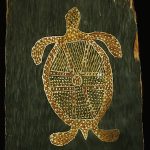Nandabitta Maminyamandja
Groote Island Bark Painting
Nandabitta Maminyamandja is one of the few recorded artists painting in a traditional Groote Elandt style. His artworks depict the origin legend stories and dreamings of the Anindilyakwa people. He was born before the first Christian mission influenced Groote Eylandt in 1921, and grew up in a traditional lifestyle.
If you have a bark painting by Nandabitta Maminyamandja please send me an image I would love to see it. If you want to sell it or find out what it is worth email me and attach a Jpeg and a size.
I am always looking to buy artworks by Nandabitta Maminyamandja.

Nandabitta Maminyamandja Art Style.
Like most Groote Eylandt paintings the majority of Nandabitta’s artworks have a black background. He often painted giant birds, sawfish, stingrays, and hunting or fishing legends. These artworks are depictions of traditional legends or songlines that explain the creation of the land. Nandabitta like Jabarrgwa likes to use all his bark canvas for design. He often framed his later works with parallel lines of pigment. When painting the figurative outline he uses a line of solid color but the infill is dos dashes or even crosshatching.
His human figures tend to be stocky and seldom have eyes depicted. He often gives the humans a sense of movement. They are fishing hunting or dancing in ceremonies. He also did at least a few barks depicting skeletons that had come back to life.
When unsigned artworks by Nandabitta can be hard to distinguish from those of Thomas Nandjiwarra Amagula or Jabarrgwa Warrabadalumba Kneepad

Biography Nandabitta Maminyamandja
I can find virtually no information on this artist. If you know anything more about Nandabitta Maminyamandja please feel free to contact me. I would love to be able to know and share more about the artist’s life
Recommended reading
Creation tracks and Trade Winds: Groote Elandt Bark paintings
Opposite: Macassan prau and processing sea cucumbers

Meaning of Nandabitta Maminyamandja Artworks

Creation story by Nandabitta
For a European it would be easy to believe that the opposite bark was only a painting of large fish. The story told however is one of the creation of the rivers and geographical features of the land
Three Alawudawarra (or ancestral beings) created the Angurugu River on the western coast of Groote Eylandt. Yukurrirridangwa the Sawfish, Dumarnindangwa the Manta Ray and Manggabaramerra the Shovel-nosed Shark. These ancestors swam from Blue Mud Bay on the mainland, to the west coast of the island. Arriving the Sawfish cut a channel in the ground and freshwater gushed out of springs to fill the channel. The Shovel-nosed Shark remained in the river and transformed into a large rock. The manta Ray companions traveled on and finally reached Lake Angurugubira on the east coast.
The black ground in the central section of the painting represents the Angurugu River. The Sawfish depicted in various locations, cuts out the river bank. In the lower left is a form that indicates sandbars at the mouth of the river. In the top corners the springs with water flowing down to fill the river. The Manta Ray, Dumarnindangwa, is in the middle of the bark, and to its lower left is Yimaduwaya, a young Stingray. Above these is the Shovel-nosed Shark. The dotted line that runs through the image traces the paths of human beings fishing for the descendants of the creator beings in animal form.
All images in this article are most importantly for educational purposes only.
This site may contain copyrighted material the use of which was not specified by the copyright owner.











